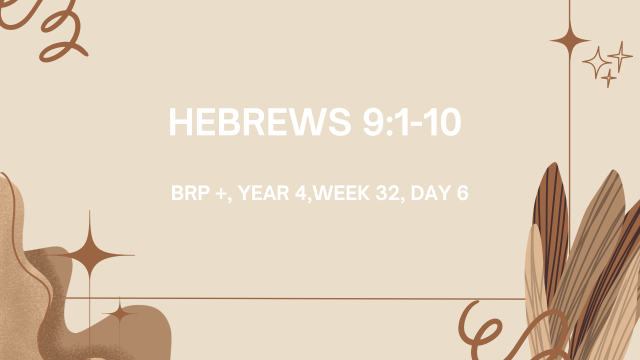Hebrews 9:1-10
Q.1. What was in the Tabernacle? What were the features and the restrictions relating to the Tabernacle? (Heb.9:1-7)
The writer explained that the first covenant had specific regulations relating to the Tabernacle. He went on to describe that in the outer tabernacle there were – 2 … the lampstand and the table and the sacred bread; this is called the holy place. 3 Behind the second veil there was a tabernacle which is called the Holy of Holies, 4 having a golden altar of incense and the ark of the covenant covered on all sides with gold, in which was a golden jar holding the manna, and Aaron’s rod which budded, and the tables of the covenant; 5 and above it were the cherubim of glory overshadowing the mercy seat … (Heb.9:2-5). The people had only had access to God through priests. The forgiveness foreshadowed by the Day of Atonement was only mediated once a year when the High Priest entered the Holy of Holies with blood for himself and for the people (Heb.9:7). There was an endless procession of priests and sacrifices throughout the generations. They never completed total reconciliation – Now when these things have been so prepared, the priests are continually entering the outer tabernacle performing the divine worship (Heb.9:6).
Q.2. What made the regulations regarding gifts and sacrifices deficient? What message does this convey? (Heb.9:8-10)
We are not left to wonder about the shortcomings of the First Covenant – 8 The Holy Spirit is signifying this, that the way into the holy place has not yet been disclosed while the outer tabernacle is still standing, 9 which is a symbol for the present time. Accordingly, both gifts and sacrifices are offered which cannot make the worshiper perfect in conscience (Heb.9:8-9). The writer wanted those Jews who were tempted to return to the provisions of the Tabernacle to recognize their massive limitations in cleansing the sinner’s conscience before a holy God. He also implied that the regulations of divine worship and the sacrificial system were only relevant while the – tabernacle is still standing (Heb.9:8). The ceremonies, rules and regulations that applied to Israel under the First Covenant, now no longer applied to believers who are under the New Covenant – since they relate only to food and drink and various washings, regulations for the body imposed until the time of reformation (Heb.9:10). What still apply are the Ten Commandments, since they are all repeated in the New Testament as being applicable. The keeping of the Sabbath is no longer obligatory because Paul wrote to the Colossians – no one is to act as your judge in regard to food or drink or in respect to a festival or a new moon or a sabbath day – things which are a mere shadow of what is to come; but the substance belongs to Christ (Col.2:16-17). Jesus also taught that – The Sabbath was made for (the benefit of) man, and not man for the Sabbath (Mk.2:27). Believers continued to go to the synagogue to preach the Gospel to the Jews. In time, they set aside the first day of the week … the day of resurrection, as the Lord’s Day (1 Cor.16:2; Rev.1:10).

